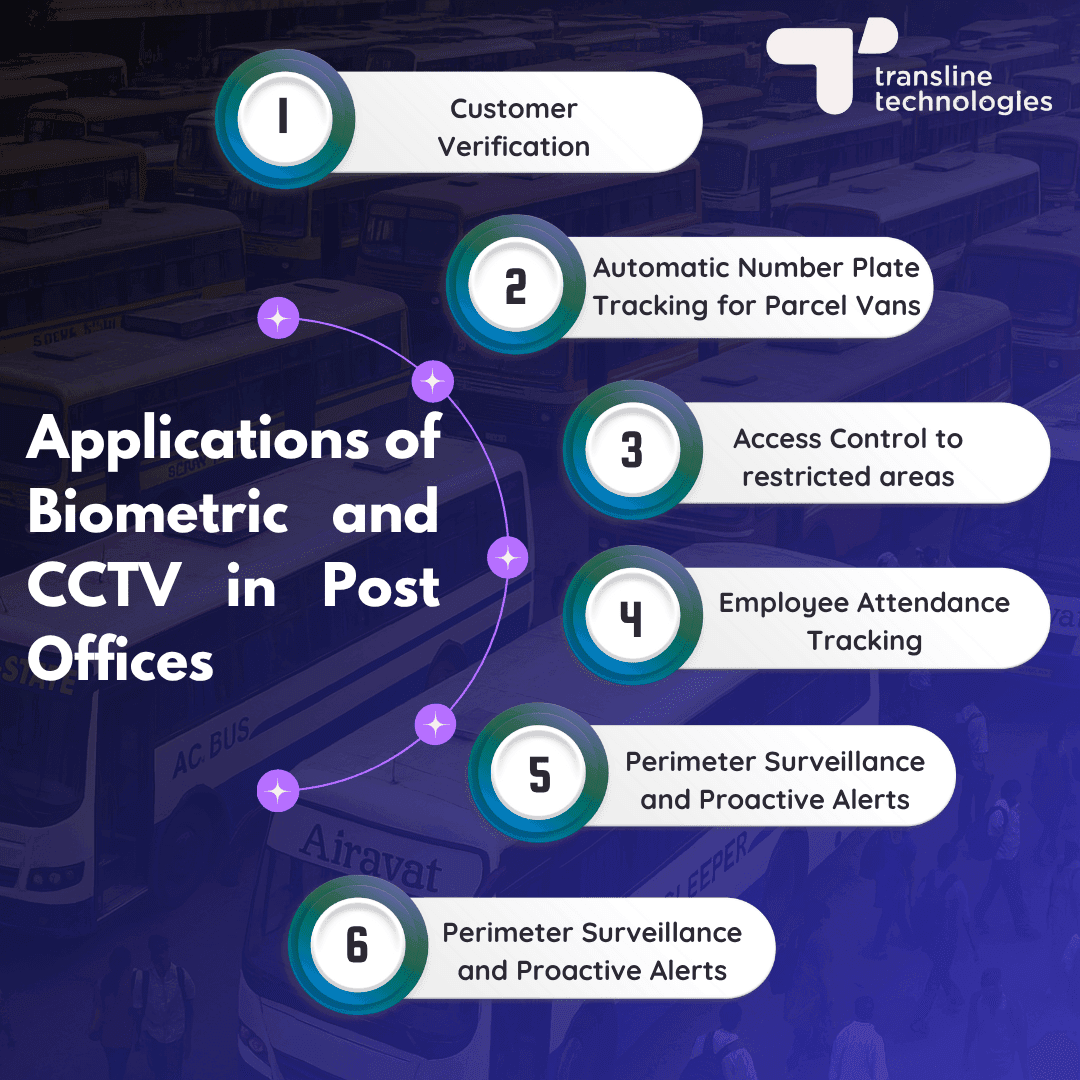
In an era where security and efficiency are paramount, government institutions like post offices are increasingly turning to technology for smarter operations. Two of the most impactful tools in this transformation are CCTV surveillance systems and biometric authentication. From enhancing post office security and preventing fraud, to improving service delivery, these technologies are redefining how post offices operate across the country.
In this article, we explore the key applications, benefits, and challenges of integrating post office CCTV and biometric systems, and why choosing the right security partner makes all the difference.
How does Biometric Authentication in Post Offices Work?
Biometric authentication is a modern security method that uses unique physical and behavioral traits like fingerprints, facial structure, iris scans, or even the way a person walks to confirm their identity. By relying on features that are nearly impossible to replicate or spoof, post office biometric systems offer a more secure and personalized approach to access control.
Post offices often handle sensitive and confidential information, making them particularly vulnerable to data breaches. From staff attendance systems that need to prevent unauthorized or accidental entries to biometric access controls that ensure only authorized personnel can manage and access critical data, strong privacy and security measures are important for maintaining post office security. Unlike traditional post office security measures such as passwords, PINs, or access cards, post office biometric verification is quicker, more accurate, and significantly harder to compromise. These conventional methods often require manual checks and are prone to breaches or misuse. As the need for faster, more reliable post office security systems has grown, biometrics have emerged as a powerful solution.
CCTV Installation in Post Offices: Why It Matters
CCTV installation is a foundational component of modern postal security systems. Post Office CCTV cameras are installed both inside and outside the premises to record video footage and proactively analyse suspicious activity. Here’s why CCTV is essential in post offices:
Crime deterrence
The presence of post office CCTVs, particularly at all vital points (places where extra safety is required or sensitive information is stored), helps avoid and discourage individuals from committing crimes like fraud or vandalism. With AI-powered post office surveillance, real-time alerts can be triggered to post office security personnel whenever an anomaly or suspicious behaviour is detected in or around the premises.
Evidence collection
Many cases, where crimes were suspected, have been solved by analysing post office CCTV footage. These have served as reliable sources of evidence for investigation. In a recent case in Karnataka, three people were traced from post office CCTV video footage and arrested on charges of theft. Recorded footage helps in post-incident investigations at post offices not only in India but also in other countries.
Staff safety
Post office surveillance protects employees, especially those handling cash or working night shifts. Even for postal delivery staff and ground-force, post office biometric systems ensure that no one can spoof their identity and enter restricted zones within the post office.
Operational oversight
Managers can review post office CCTV camera feeds to ensure efficient operations and compliance with protocols. Moreover with AI powered video analytics softwares like StorePulse AI, accurate insights can be derived regarding potential inefficiencies and security risks in the postal system.
Applications of Biometric and CCTV Systems in Post Offices
The integration of post office biometric authentication and CCTV systems offers several applications that enhance both security and service quality. Let us look at some of the key applications of post office biometric and CCTV systems.
Customer Verification for financial services
Biometric authentication systems help verify a customer's identity, eliminating the risk of impersonation and fraudulent activities. CCTVs create a deterrent effect by instilling the fear of being caught, thereby discouraging fraudulent attempts during transactions and money-related services. In December 2024, the Government of India launched an initiative to transform post offices into central hubs for rural financial inclusion, enhancing access to financial services in remote areas. This has consequently increased the demand for robust and accurate security systems.
Access Control to restricted areas
With post offices evolving as important financial transaction centres for the masses, identity authentication for access control to restricted zones within the post office is turning out to be a priority for postmasters. Post offices have several designated areas such as service provider desks, display zones, and transaction counters that require 24/7 surveillance due to the storage of confidential information. Since post offices are responsible for protecting individuals' privacy, access to sensitive zones is granted only to authorized personnel. This access control, integrated through biometric authentication, ensures that no unauthorized entry or data breach occurs, thereby enhancing overall security and safety. Several post offices have installed CCTVs to enhance security and actively eliminate the risks of fraud entries.
Post Office Biometric and Facial Recognition for Employee Attendance Tracking
The age-old employee attendance systems, such manual registers and card-based attendance marking, have time-and-again proven to be inefficient and inaccurate. Hence more and more post-offices are adopting biometric attendance systems such as fingerprint recognition, palm-vein scanning, iris scanning etc. In recent times, AI-driven facial recognition based attendance is becoming popular in post offices – these systems do not require new hardware infrastructure and can be integrated with existing post office CCTV hardware.
Automatic Number Plate Tracking for Parcel Vans
Parcel Vans and other vehicles entering and exiting the post office premises must be tracked to ensure that security threats do not arise from such vehicle movements. AI-powered post office CCTV cameras employ ANPR algorithms to track and record the vehicle registration numbers of all vehicles at the entry and exit gates. This ensures both operational record keeping, as well as post office safety by preventing entry of blacklisted vehicles.

Perimeter Surveillance and Proactive Alerts
CCTVs monitor entry and exit, as they are generally installed at key access points, helping to prevent unauthorized entries. Additionally, biometric authentication tools restrict access to only authorized personnel, providing double-layered security. When integrated with AI, CCTV systems become smarter and can flag potential hazards or suspicious activity in real time, helping to prevent chaos and crimes before they actually occur. Moreover, some AI-powered post office CCTVs help detect and alert when non-employees are present in restricted areas.
Smart Queue Management
Post offices often have long queues of people, which can become chaotic and disorderly. This can lead to overcrowding and sometimes even fights, highlighting the need for proper crowd management. AI-driven post office surveillance systems with features like crowd detection and fight detection can actively monitor and help manage queues, making post office service operations smoother, faster, and more manageable.
Together, these tools make post office applications more secure and reliable for both staff and customers.
Post Office Security: A Broader Perspective
While post office CCTV and postal biometric solutions are foundational to modern post office security, a truly secure environment requires a broader, multi-layered strategy. As post office services expand into financial and digital territories, safeguarding them demands more than just cameras and scanners. Cybersecurity plays a critical role in protecting sensitive customer data and digital transaction records from breaches. At the same time, physical security measures like reinforced entry points and panic buttons ensure safety against on-site threats. Cutting-edge tools such as AI-powered behavioral video analytics can detect unusual activity of visitors from post office surveillance video footage in real time, enabling quicker response to potential security issues. Comprehensive staff training on emergency protocols and system usage is equally vital, ensuring that human oversight complements the technology. Additionally, alarm systems integrated with surveillance infrastructure provide an added layer of rapid alert capability. Together, these elements reinforce the integrity of postal services and foster greater public confidence in post office safety.
Challenges in Implementation of Post Office CCTV and Biometric Systems
Despite their benefits, installing and maintaining security systems in post offices is not without challenges:
Infrastructure limitations in rural or remote post office locations
In India, there are more than 1,50,000 post offices and most of these are located in rural areas. However, in rural areas, post offices often face operational challenges due to the lack of modern facilities, inconsistent electricity supply, and unstable internet connectivity. Additionally, remote locations combined with poor transportation infrastructure frequently cause delays in mail delivery and collection. Another significant challenge is the difficulty in locating accurate addresses. Many rural regions lack proper house numbers, street names, or well-defined landmarks, primarily due to underdeveloped infrastructure. This absence of standardized addressing complicates the efficient sorting and delivery of mail.
Cost concerns in retrofitting older post office buildings
Installing CCTV and biometric systems in older post office buildings can be particularly challenging due to outdated infrastructure. Many of these buildings were not designed to support modern technology, lacking adequate wiring, network connectivity, and space for new equipment. Structural limitations may also restrict where post office CCTV cameras and biometric scanners can be placed – preserving historical or architectural features can further complicate installation. These factors make retrofitting both technically demanding and time-consuming.
Privacy regulations around post office biometric and CCTV data storage
CCTV storage management is a major concern for post offices across India due to privacy risks and storage costs. With modern CCTV storage optimisation softwares, post offices are now actively taking initiatives to cut down video storage costs significantly. Moreover, selecting the right post office CCTV solutions provider ensures compliance with global data security standards, thereby reducing privacy risks.
Technical training gaps for staff using new post office solutions
Many post office staff may not be well-versed with modern technology and other technical advancements. Over time, many technical upgrades have been introduced in post offices. However, a lack of familiarity with these new technologies, specifically with biometric tools and modern CCTV systems, can lead to operational delays and errors. This shift demands proper training sessions for staff, which in turn requires time and resources. In such cases, most staff may feel overwhelmed which may lead to decline in their confidence and efficiency.
Maintenance and hardware upgrades of postal security systems over time
Over time, CCTV systems have been upgraded, and advanced surveillance and biometric authentication devices such as palm vein recognition, fingerprint scanner, and more, have been introduced in post offices. This drastic technological shift has required significant hardware upgrades and regular maintenance, requiring effort, labor, costs, and time. Moreover, regulatory compliance becomes essential as upgraded systems must adhere to standard rules and regulations related to data protection and privacy concerns.
Overcoming these hurdles requires collaboration between postal authorities, government bodies, and private security vendors. This, again, is a challenging task due to various constraints such as limited budget, lack of unified standards, and bureaucratic delays. However, these challenged can be addressed with proper planning and effective communication and coordination
How to choose the Right Post Office CCTV and Biometric Solutions
With the rapid digitization of post office services in India, there is an urgent need to adopt secure, reliable, and efficient solutions. Post office biometric authentication and AI-powered post-office CCTV surveillance are more than just security upgrades – they are crucial investments in customer trust, public accountability, and service excellence.
As postal services continue to serve millions daily, implementing modern post office security systems helps meet the dual goals of accessibility and safety, reinforcing the critical role post offices play in public infrastructure. Selecting the right post office safety solution involves evaluating specific needs and constraints:
Scalability
The post office biometric authentication system and AI post office surveillance solutions should be highly scalable, so that implementation can be started from the Head Post Office in a particular circle, and then scaled across all the Sub-Post Offices.
Integration
Since Post Offices in India already operate under a tight budget, installing new CCTV network and storage infrastructure for AI post office surveillance is an expensive game. Hence, AI CCTV solutions for post offices must be easily integrable with existing vanilla CCTV infrastructure.
Vendor reputation
The reputation of the post office CCTV and post office biometric solutions provider is an important consideration, since technical expertise and customer support helps in forging a long-term commitment.
Compliance
It is important for the post office CCTV solutions to meet national and local security and privacy standards. For post office biometric authentication systems too, the highest levels of data security must be ensured, because these systems are often integrated with payment gateways and other high-risk financial infrastructure.
Support
Ongoing 24x7 technical support and training of concerned employees and security personnel is necessary to ensure optimal utilisation of post office surveillance and biometric systems.
At Transline Technologies, we are eliminating security challenges and improving operational efficiency for Post Offices with real-time AI-powered CCTV surveillance, Biometric and Facial Recognition solutions, Advanced Network Health Monitoring, and CCTV Storage Optimisation solutions. Whether you're managing the PO branch in a large city or a small rural SO branch, we shall assist you in choosing tailored biometric authentication systems and CCTV setups to secure your post office premises.
Contact Us today to explore our solutions.



